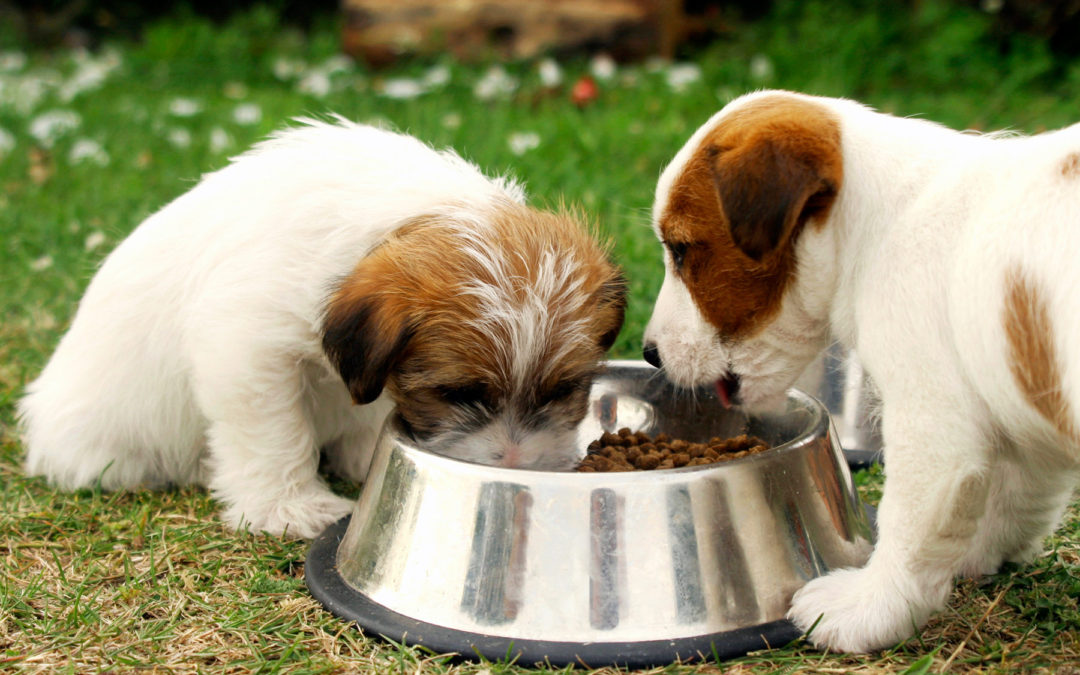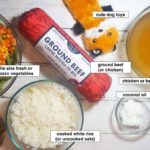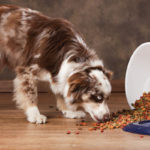Dod Food guide – Every living being needs food to survive, and dogs are no different. On feeding habit, dogs are evolved omnivorous not minding the fact that they share a common ancestry with wolves. Even though dogs are omnivores like humans, they, however, cannot eat everything humans eat.
Totally overlooking this dissimilarity, dogs also need a proportioned ration of some nutrients in their meals to grow and develop without any deficiency. So every dog diet should contain these main food classes; protein, vitamins, carbohydrates, minerals, fats and water.
In addition, knowing what and what constitutes a balanced diet in respective proportions is a necessary knowledge every dog owner or dog parent should have since most dogs depend on their owners for sustenance and overall nutrition.
Also, feeding your dog with the best food sources will help them reach their apex (both mentally and cognitively), eliminate health challenges, stomach upsets and allergies, and promote total wellbeing.
Knowing and understanding all these is not rocket science, and this dog food guide is here to help you understand your dog’s nutritional needs better as simply walking down to a store to purchase a random dog food would not solve this problem.
While discussing the nutrition of dogs; what should be and shouldn’t be included, it is important to note that there are certain factors that should determine the food sources and the needed nutrients in their right proportions in these food sources since dogs need different nutrients at different times and for different purposes.
Choosing and planning diet plans around these factors and the respective dietary requirements is crucial as full compliance would totally eliminate malnutrition, growth retardation, sicknesses, food allergies and sensitivities.
This dog food guide offers a well-detailed breakdown of the types of dog foods in their different forms, their pros and cons, the different dietary requirements of dogs based on life stages, and the importance of all food classes and the need for their subsequent inclusion in dog foods.
There are thousands of dog foods out there, and these many options do not make choosing easier. A random trip to the pet section in a mall or a pet store will reveal the many types of dog foods that are available out there, from the kibble brands to the much exclusive refrigerated fresh dog foods. On a broader categorization, dog foods are divided into complete dog foods and complementary dog food.
- Complete dog foods:
Complete dog foods are types of dog foods that (which regards to its constituent sources) meet the daily dietary requirements your dog needs in their required proportions and so can be served as a whole balanced meal (according to certain standard nutritional guidelines).
Most dog food brands usually have “complete” on their packs, and it is assumed that such brands contain all the required daily nutrients (and in their right proportions) that your hound needs to grow and stay healthy. These ‘complete’ dog foods can come in any form; dry, wet, fresh, or refrigerated.
- Complimentary dog foods:
As the name implies, complimentary dog foods are types of dog foods that are meant to be served alongside complete foods or well-balanced meals as side pieces. These food are opposites of complete foods and do not contain all the required constituent nutrients to meet your dog’s daily dietary requirements. Just like complete dog foods, they can come in any form as wet or dry foods as topper, cuts/bits, or treats. Some dog food brands produce complimentary dog foods that are to be served with other complete dog foods in the same products category.
Moreover, both complete and complimentary dog foods can come in cans, in kibble sizes, as home-made or as frozen fresh. To this effect, more information on these categories of dog food is crucial in helping dog owners choose the right form or texture of food for their canine companions. This is made easier by simply reading the nutritional table and daily feeding guidelines on the pack of the food.
- Dry/kibble dog food
Lacking moisture, the dry or kibble dog food consists of various nutritious ingredients, cooked and crushed into tiny kibble shapes. Dry or kibble dog food is the common and often the most affordable dog food. As a brand of dog food, it can stay for a longer time and retains its nutrients without proper preservation because of its dry form. Also, it is convenient as it often comes in sealable pouches or bags and discourages against spills.
Due to its dry nature, it is less messy as it doesn’t leave behind food particles or cause dental issues. In general, this type of dog food promotes good oral health than other types of dog food. On production process, dry or kibble dog food can be baked, extruded, cold-pressed, coated, air-dried or freeze-dried.

Production Processes Of Dry Dog Food
- Baked– This process of making dry dog food involves cooking at a lower temperature than the extrusion method allows. This methods relies more on gluten binding, gives out tastier and softer kibble bits that are easy to digest, and ensures that some of the nutrients in the food sources are not destroyed.
- Cold dried-The cold dried method is like extrusion but the extruded pellets are gotten at a lower temperature without applying steam. This method is favoured because it is less destructive of inherent nutrients than the extrusion method.
- Extruded– The extrusion method is a more traditional method where the constituent food materials are dried and weathered down to a dough that is then further processed down to the form of pellets. The resultant little bits are cooked (at high temperature) and subsequently coated with preservatives to guarantee a longer shelf-life. This production process is slowly being abandoned as it destroys most of the nutrients contained in the composite food items. However, most dry dog food brands try to replenish these destroyed nutrients through the process of coating.
- Freeze dried-This method is similar to the air dried method, but unlike the air dried methods the ingredients are initially frozen before applying heat to remove moisture. This method ensures that less nutrients are destroyed during production. Dry dog foods produced through this method are expensive and often need to be softened with water before feeding to dogs.
- Coated-coating is not a standard dry food production method but more like a post-cooking process. This process is used to add more nutrients (usually in the form of vitamins and minerals) or flavours in other to enrich dry dog foods.
- Air dried-This production method involves initially exposing the ingredients to heated air which slowly dries out the nutrients during evaporation. This process of dehydration is believed to destroy some of the nutrients contained in the ingredients. For most dry dog food brands made through this process, it is necessary to rehydrate with water before feeding your dog with it.
It is important to note that the production process of a kibble or dry food brand matters as it can affect the nutritional gains it offers. In addition, before purchasing a dry dog food brand, it is important to know the production process and the ingredients used as some of these nutrients can break down or be destroy during production. For example, a dry dog brand produced through the cold-pressed method is more nutritious and appealing than that produced through traditional extrusion.
Generally, freeze dried dog foods are preferred over those produced through other methods under the dry food category because its production process is less destructive of inherent nutrients, and gives out an end product that is easily digestible. Although more expensive, freeze-dried dog foods are longer lasting even without the addition of preservatives.

- Canned/wet dog food
Canned or wet dog food is the type of dog food that has more water consistency and often come in cans, trays, pouches and jars. It often includes food pieces or bits that are processed, cooked and then sealed air-tight in base substances like jelly, sauce or gravy. Part of this sealing process includes decontamination. Both decontamination and air-tight sealing guarantee durability without the addition of synthetic preservatives. However, most nutritionists believe that these processes destroy or reduce the proportion of the nutrient.
Canned or wet dog food are usually preferred because of their texture and marshy nature. Their high water content protects against dehydration and adds to their gustatory appeal. Also, they are very expensive and less economical. They are perfect for puppies since their softer texture makes it easier to chew and protects against dehydration, and also rationing is more practicable with this choice of dog food.

- Home-made dog food
Recently, home-made dog food has gained popularity among dog owners. This recent trend could be attributed to attempts to provide dogs with healthier, more nutritious and more hygienic diets as many people already doubt the authenticity of the quality of ingredients used in commercial dog food.
This could also be inspired by fashioning diets for your hounds based on specific dietary requirements due to food intolerances or eating conditions. Home-made dog foods are often made with food sources and crumbs from the kitchen. While making dog food it is important to know the essential food items, their respective benefits and required proportions, and the food items to avoid.
Preparing your dog food yourself isn’t as difficult as the thought seems. It can range from simply blending some food sources to puree form to selecting and cooking food items. Also, they are hundreds of free home-made dog food recipes available online that can help a dog owner get started even with a little knowledge of canine nutrition. With respect to type, home-made dog foods can either be raw or cooked, depending on the dog’s taste buds or the nutritional goal aimed at.
On the benefits, preparing your dog’s food yourself allows you more control over your dog’s diet and nourishment. However, the process of making such foods can prove too demanding (both time and labour wise) and sourcing for high-quality foodstuff can be expensive for the dog owner. To help with these problems, the option of preservative options could be considered. Also, including leftover meals at home can also help with offsetting cost.

- Raw Dog Food
Raw dog food is another type of dog food brand that is slowly becoming a favoured option. The philosophy behind this category of dog food is pre-evolution nutrition, feeding dogs what they ate before they became kept at home as pets or evolve to become omnivores.
Raw dog food is pretty packed with a nutrient-rich combination of vegetables, fruits, kidney and liver, brisket bone, and raw meat. Raw dog foods can either be commercially-made or home-made, with the commercial option often coming frozen in bags or pouches. This sort of dog food can either be a complete meal or side alongside other meals.
This category of dog food is often lauded for its many benefits like increase of gut-friendly bacteria, more energy turnover, finer/shinier coat and skin, and increased protein levels. However, raw dog food are not entirely without flaws. It is assumed that the presence of raw meat can introduce meat parasites and bacteria like Salmonella E that thrive in contaminated meat parts.
In addition, knowing the amount of needed nutrients and their required proportions can be tricky with this kind of dog food. For instance, a puppy would not need the same dietary proportion as an adult dog would, likewise a dog with kidney problems or pancreatitis.

- Semi-Moist Dog
Like the name implies, semi-moist dog food is like dry dog food but with more water content, like up to 63% in staggering contrast to the 10% found in dry dog foods. This type of dog food is also known as semi-dry dog food and like a product merge of dry dog foods and canned dog foods.
Semi-moist dog food is convenient and appetizing, with high protein levels. On the other hand, it is not so popular with dog owners because of its artificial additives (like colours, fillers and preservatives) and high sugar and sodium content. This fact about its constituent ingredients and their respective nutritional benefits makes this type of dog food unsuited for all dogs.
In addition, semi-moist dog foods can either be complete or complimentary, meaning that they can be served as whole balanced meals or served in addition with other meals.
Life Stage Nutrition
Asking what and what to feed a dog with is not enough as due consideration has to be paid to a dog’s particular needs at a given time when choosing food type and the respective nutrients they contain. This is because at every stage a dog has a specific set of dietary requirements, and these requirements change as the dog transitions from one stage to another.
For instance, nutritionists would recommend how necessary some nutrients and their required quantity are to puppies, and these set of nutrients would likely change or increase to accommodate others that will help with growth functions as they age.
In addition to choosing the right dog food brand/type and their contained nutrients, the idea of rationing food portion also comes into play. Just as sourcing the right nutrients is essential, making sure that dogs do not overfeed or underfeed is crucial too as either of the two conditions can hamper a dog’s overall growth and development.
- Puppies

Puppies are young dogs. They are playful, active, and have rapid growth. From four to six months, they are weaned and introduced to solid food. Now detached from the nutritional benefits of breast milk, they need nutrients like calcium, vitamins and minerals, essential fats, and protein that would help them build strong teeth and bones, grow shiny and healthy coat and skin, and from internal systems.
For this, some dog food brands have products specially formulated for puppies which are rich in phosphorus and calcium and are known as “weaning foods”. It really doesn’t matter if you are choosing weaning foods or all-inclusive (all-life stages) dog foods, the main things to know include making sure the chosen dog food has a soft and easily-digestible texture, contains high levels of calories, protein and calcium, and is enriched with vitamins and minerals.
On rationing, puppies generally are always hungry but from four to six months it is advised you feed them four to six times daily to discourage overeating or excess weight. Four times for medium rations and six times for smaller rations depending on the dog breed.
From six months upwards, their feeding pattern can change slightly depending on their growth rate. And for large breed puppies, dog owners should totally consider choosing breed formulated recipes so as to make sure their gradual growth and development rate corresponds with the consumed nutrients.
On the type of dog foods for puppies, wet dog food brands are often preferred over the other types because of the softer texture, palatable appearance, and balanced attributes. Also, dry dog food can be patronized, but only the ones that need to be hydrated before feeding the dogs with. Overall, make sure that chosen commercial dog food brands met certain nutritional standards or are endorsed by nutritionists.
- Adult dogs

As dogs grow from puppy to adults, almost everything about them changes including their feeding pattern, the diet itself and their nutritional requirements. Adjusting to this changes is not so difficult since your dog at this stage already has a predictable set of habits and preferences. For example, at the stage every dog owner is aware of what their dog hates and likes, the type of food they like, how frequently they eat, and some ingredients they are insensitive to.
At this stage, their requirement for nutrients that aid growth and development is to be replaced with nutrients that nourish, promote and maintain. This however is dependent on the dog’s growth rate and physical condition. An underweight adult dog or dog that doesn’t reach expected stage growth or weight can be placed on diets that would help with their deficiency, same with an obese dog.
For adult dogs that reach expected adult growth expectations, it is advised you feed them with dry, wet or raw foods that are rich in protein, minerals, vitamins, essential fatty acids, majority of which should come from animal sources and are easily-digestible. Their meals should be grain and gluten-free, have more protein and fat content since they are main energy sources, then fruits and vegetables. The constituent food items should be highly-sourced and natural. For obese and large breed dogs, the level of fat in their meals should be low.
When rationing food portion, things like a dog’s weight, breed, and level of activity should be considered. An adult dog should eat once or twice a day, depending on portion size and consistency. Also, dry dog foods and semi-moist foods are perfect for dogs at this stage because it promotes good oral health, is less messy, more convenient, and is cost-efficient.
- Senior dogs

Senior dogs are faced with aging problems and overweight and as such require nutrients that perform repair and maintenance functions, with strong focus on fortifying their debilitating immune system. Also, at this age their eating habits and nutritional needs are different, with signs like an increased continuous loss of appetite, higher blood sugar levels, and weight loss. So their foods should have lower fat and calories content (due to lower rate of metabolism), with an increased amount of vitamins, minerals and essential fats, prebiotics and probiotics, and antioxidants, while bearing their health conditions in mind. In addition, senior dogs especially those suffering from kidney and liver diseases should be placed on diets with lower levels of sodium and sugar. To meet up with these requirements and changes, it is advised to choose dog food recipes formulated specially for older dogs.
Wet dog foods seem the perfect choice to feed geriatric dogs with because they have a softer consistency, are easier to digest, and have higher water content than other types of dog food. The higher water levels is good because it helps with the problem of dehydration common among older dogs. Dry dog foods that come in smaller chewable sizes are also recommended as their size makes it convenient to consume. Regular visits and recommended supplements are advised and will be of great help.
- Pregnant and Lactating mothers

When a bitch is pregnant or nursing, her feeding habits and dietary needs are bound to change. When planning a pregnant or lactating dog’s diet, her weight, breed, and factors that should be seriously considered. While some pregnant dogs are likely to gain weight, some might lose some weight and should be closely monitored. In general, pregnant bitches need balanced diets fortified with the six classes of food from the onset of the pregnancy to parturition.
Some nutritionists would advise dog owners to feed pregnant bitches puppy recipes. This is believed to provide her and her babies with the right nutrients they need for sustenance. However, this transition from adult dog food to puppy recipes should be gradual.
On food type, they should be fed with meals that are rich in fats and protein, especially dry dog food. Balanced dry dog foods are excellent choices as they are more satisfying and more economical. However, special attention should be paid to their hydration. Furthermore, they can also be fed wet dog food, as long as there is an increase in portion as the pregnancy progresses. As this stage, it is necessary to monitor their feeding as underfeeding or overfeeding the dog will have terrible consequences.
- Working and active dogs

Working dogs as their name implies are athletic dogs that are trained to help out in carrying out occupational tasks. Working dogs include: search and rescue dogs, military dogs, guide dogs, assistance dogs, guard dogs, herding dogs and therapy dogs. Some pure breed dogs are often described as working dogs because of the physical attributes and cognitive ability. Some working dog breeds include: Tibetan Mastiff, Neopolitan Mastiff, Rottweiler, Siberian Husky, Saint Bernard, Swiss Mountain Dog, etc.
For working dogs, it is necessary they get the right and balanced nutrition because of their energy-expending lifestyle. So their foods should have high fat content, followed by protein, vitamins and minerals. The protein source should be animal-based protein, especially a novel animal-based protein.
In addition, they should always stay hydrated at all times, so feeding them wet dog food would be beneficial at this point. Their meal should contain nutrients that help with the growth of strong muscles, support join flexibility, help with quick recovery, and are easy to digest and be used by the body.
On their feeding pattern, working dogs should be fed after completing a tough task and never before. Feeding them before a tasking activity can lead to stomach upset or other digestive complications.
On the other hand, active dogs as a generic name often refer to working dogs and other athletic dogs. Active dogs are very energetic and have more nutritional needs than ordinary dogs, so their meals should contain loads of energy and calories.
All working and active dogs, whether puppies, adult or senior dogs need to be fed with balanced meals. This can be in the form of home-made or commercial meals. For commercial meals, there are specially formulated recipes for working/active dogs. Before purchasing commercials dog food, whether complete or complimentary, it is important to check the list of ingredients and their nutritional values.

Classes of Dog Food
- Protein
Protein is one out of the macro nutrients and should be contained in every food your dog consumes as they cannot live without it. In addition to supplying energy, they also help with building and increasing muscle mass.
There are animal-based and plant-based protein, however animal or meat-based are superior to plant-based protein because they are easily digested and more natural. Also, even though plant-based protein are cheaper and more accessible than animal-based protein sources, they are not great options because they are harder to digest and absorb and often cause digestive upsets. Meat meals are also great options since they are denser and therefore have more protein levels than meat protein.
For animal-based protein sources, novel protein sources are the best. Novel protein is used to refer to fresh protein sources that your dog is yet to be introduced to. Protein sources like salmon, herring, venison, kangaroo and duck are often considered as novel sources because they are usually not common ingredients in most dog foods.
- Fats
Fats or dietary fat is sourced from meat fat and oil seeds. They are more concentrated and so give more energy than protein and carbohydrate. In addition to providing energy, they also help with digestion, bowel movement, and cognitive development. Fats include omega 3 and 6 fatty acids, often known as essential fats, are very important and should be compulsory ingredients in every dog food. This is because they help with nourishing and maintaining good skin and coat health, and promoting good sight.
Even though fats are essential macro nutrients, excess quantity of it can lead to obesity and heart diseases in dog and so should be regulated. This can be done be making sure that preferred dog food brands or types are formulated without animal fats and harmful oil supplements, especially the ones that increase cholesterol levels. So it is necessary that every dog owner reads the label and list of ingredients on any dog food before purchasing.
- Carbohydrates
Carbohydrates in dog foods are mostly sourced from plant-based options like vegetables and grains. Whether plant sourced or not, the constituent carbohydrate should be easy to digest and absorb. Some nutritious sources of carbohydrate include: barley, rice, wheat, corn and some digestible fiber sources. Carbohydrate provides energy and helps to promote your dog’s immune system.
- Minerals
Dietary minerals or simply “ash” in dog food brands include nutrients like phosphorus, calcium, zinc, selenium, iron, manganese, copper and magnesium. Minerals are micro nutrients that are actively needed for almost every function in a dog’s body. They perform functions like secretion of hormones, formation of blood cells and skeletal support (bones and teeth), energy breakdown, support enzyme reactions, and maintenance of neurological transmissions. Deficiency of some major vitamins can lead to bone and skeletal deformities.
- Vitamins
Vitamins are essential nutrients as they provide body building and repair functions in the body. Balanced dog foods should contain vitamins A, K, D, E, Calcium, B-complex and phosphorus. Dogs do not necessarily need vitamin C because their body produces it on its own.
As main nutrients, vitamins help with growth of joints, blood clotting, foetal growth, cognitive development, metabolism and strong immunity.
Most importantly, when settling for home-made dog foods or other types of dog food, it is important to know that vitamins are easily destroyed when subjected to high temperature. So it is important to go for dog food types that still have a higher percentage of their vitamin content still intact.
- Water
The nutritional benefits of water to every living thing cannot be overemphasized. Water helps with capillary actions, especially with the digestion and immersion of consumed nutrients, and helps to regulate body temperature. The amount of water consumed depends on the dog’s habits, special needs and stage. Extra care should be taken to make sure that their bowls are filled with water at every time.To further help with the problem of dehydration and constipation, wet dog foods should be introduced into your dog’s diet.
Special Dietary Or Therapeutic Recipes for Dog
Some dogs have peculiar health conditions and feeding preferences and so do not consume foods eaten by other dogs. A dog could be allergic to certain food items, are diabetic, have pancreatitis, kidney or heart diseases. Such dogs are then placed on special diets knows as prescription or therapeutic diets. Prescription diest therefore are holistic recipes that are specially made to meet certain dietary and medical needs.
Prescription or therapeutic diets can come bearing tags like low sodium, low calorie, low carb, low sugar, low phosphorus, hydrolyzed, high fiber, high calorie, diabetic, etc. however, it is important to seek a veterinary doctor’s opinion before settling for any of these special recipes. Also, a cursive glance through the list of ingredients can also help a dog owner ascertain if a particular product is suitable for their dog or not.
Daily Feeding Guidelines And Feeding Methods
Dogs are greedy eaters and if allowed will eat as many times as possible in a day. Allowing them to eat freely is dangerous as worst things than obesity could happen. On an average, dogs should eat two times in a day, depending on age, breed and dietary requirements.
For puppies, they should be fed smaller but frequent portions. Whether small, medium or large breeds, it is advised to feed them 3 to four times daily and their feeding should be timed. This rationing will make sure they do not overeat or look malnourished.
For adult and senior dogs, it is advised to feed them according to how much they weigh. Form their weight it would be easy to calculate their need nutrients intake and feed them accordingly. In general, adult dogs should be fed twice a day, and their feeding should be timed. Sticking to a timed schedule while feeding dogs is beneficial and recommended as it helps to regulate their feeding habits.
Also, changing a dog’s diet can make them eat more or lose appetite often. On this, dog treats and recommended supplements can be introduced as part of their diets.
ALSO SEE: 10 Best Dog Foods For Pitbulls
Some Foods Items To Avoid
Some food items are allergenic or simply bad for dogs. And since dogs are enthusiastic and want to eat everything in sight, extra care should be paid to what they eat at all times.
Here is a list of item that should be kept out of every dog’s diet
- Chocolate, coffee and other items that contain caffeine
- Grapes and raisins
- Onion and garlic
- Salt and salty meals
- Yeast dough
- Alcohol
- Raw eggs
- Nuts
- Avocado
- Milk and other dairy products
- Peaches and plums
- Raw meat and fish
- Sugary foods
- Drugs taken by humans
Conclusion
Every dog needs balanced and well-proportioned meals. This is because good nutrition does not only sustain life but also helps with the growth and development of the dog. As dogs have evolved to become thriving omnivores, just like humans, their meals should include all essential nutrients needed to support bodily functions. Also, dog owners can enlist a veterinarian’s help in choosing the right dog food if dog nutrition seems too big of a subject matter to understand fully.
On purchasing commercial dog food brands, it is advised to purchase only premium dog food brands and to stay away from dog food brands that contain supplements and fillers. But instead, buy brands that contain organic food sources, are human-grade, contain farm-grown animal and plant materials, and contain novel protein.
In addition, every premium good dog food must
- taste nice/ be delicious
- be appetizing or palatable
- be balanced/must contain all essential nutrients
- be easily digestible and absorbable
- be toxin-free
- be sodium-free
- be gluten-free
- be grain-free











